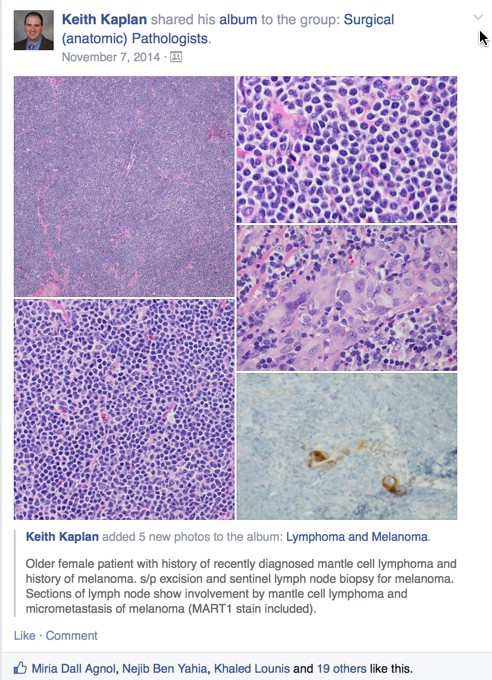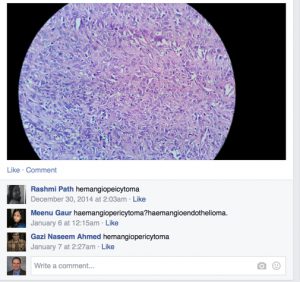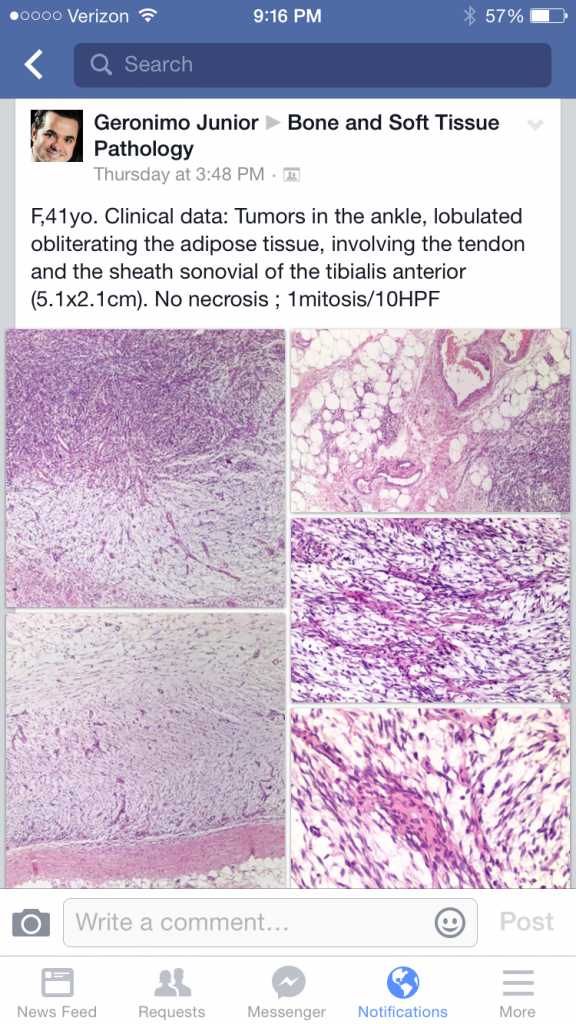Facebook for Pathology Consultations: We Can but Should We?
 Everyday in dozens of groups on Facebook pathologists from all over the world post images of pathology cases with brief clinical histories, gross descriptions and/or IHC or other ancillary test information for a couple of purposes. One is to case share with other members in the group, sharing their diagnosis, opinions on the case and making available to others generally high quality images to use for their own education or perhaps to share as an example of a particular disease entity later. Often times these cases are shared in respective sub-specialty groups by recognized sub-specialists within their field. These mini case write-ups serve as an easy way to for group members to collaborate and share their own experiences and perhaps provide additional questions to be asked or references regarding prognosis or treatment options.
Everyday in dozens of groups on Facebook pathologists from all over the world post images of pathology cases with brief clinical histories, gross descriptions and/or IHC or other ancillary test information for a couple of purposes. One is to case share with other members in the group, sharing their diagnosis, opinions on the case and making available to others generally high quality images to use for their own education or perhaps to share as an example of a particular disease entity later. Often times these cases are shared in respective sub-specialty groups by recognized sub-specialists within their field. These mini case write-ups serve as an easy way to for group members to collaborate and share their own experiences and perhaps provide additional questions to be asked or references regarding prognosis or treatment options.
There is another group of users that is perhaps more interesting in my opinion, namely, pathologists from overseas who often times post snapshots of cases through their oculars presumably on mobile devices and upload cases to the group for purposes of obtaining a diagnosis, asking what additional stains to order, if available to them or getting additional information in terms of what questions should be asked of the clinician when rendering their diagnosis.
These clinical scenarios and images, unfortunately, are not nearly as good as when cases are buttoned down and presented by known sub-specialists. Radiographs may not be available nor gross photos. One is presented with a crude snapshot of disease and left to comment or not to comment.
 Nonetheless, many people often reply with additional questions or opinions as to what they think the lesion may be and often times some suggestions regarding follow-up.
Nonetheless, many people often reply with additional questions or opinions as to what they think the lesion may be and often times some suggestions regarding follow-up.
In turn, the referring pathologist with minimal resources to either obtain a full pathology consult either through analog or with whole slide can often times have many pathologists, including sub-specialists assist them with the case.
This of course is really nothing new. For decades now pathologists have been e-mailing images to colleagues all over the world in hopes of getting their opinion or asking directed questions about the entity. More recently, digital pathology networks with both national and international clients have been using digital pathology with established relationships between the referring and consulting pathologist(s). There are clinical business models (and revenue streams) attached to this with appropriate business associate agreements, licensure, credentialing, malpractice coverage, etc… as part of these networks/practices.
With these Facebook groups however, any member of the group may submit and any member of the group may reply/comment as he/she sees fit in a more informal manner.
The good news is that pathologists without resources to do so otherwise, may get additional opinions for no cost and the bad news is that pathologists without resources to do so otherwise, may get additional opinions for no cost.
The dialogue is largely a social free-for-all on what someone thinks a diagnosis is and what the others contribute. It is unregulated and not reimbursed or part of any established relationships beyond belonging to the same group on Facebook for purposes of case sharing.
 Nonetheless, there is the opportunity for additional opinions and getting questions answered and the opportunity to help a pathologist and patient thousands of miles away at a low cost and perhaps with little risk in doing so although I suppose this needs to be tested if it hasn’t already. Is there really enough information presented as to make a diagnosis? Is there a physician-patient relationship established?
Nonetheless, there is the opportunity for additional opinions and getting questions answered and the opportunity to help a pathologist and patient thousands of miles away at a low cost and perhaps with little risk in doing so although I suppose this needs to be tested if it hasn’t already. Is there really enough information presented as to make a diagnosis? Is there a physician-patient relationship established?
Perhaps use of the cloud and bringing people together for pathology or as I refer to it as “Pathology 2.0” will someday see large networks established with vetted contributors and consultants in fee-for-service models for users with minimal resources to obtain low-cost diagnoses or second opinions.
For right now I think these should be regarded as educational and potentially informative with the caveat that while these social media networks may be helpful for underserved areas and pathologists doing their best to help patients, more formal business models need to be designed to protect patients and providers alike.

































